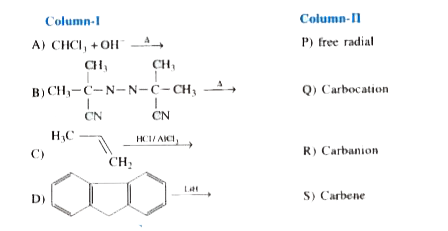Two samples of water A and B having concentration 16.2 pp m of Ca(HCO3)2 and 13.6 pp m of CaCl2 respectively. Then Solution in Telugu
Hardness is more in 'B' sample than in 'A'
Hardness is more in 'A' sample than in 'B'
Hardness is same in both cases
Hardness in sample 'B' is twice that of the sample 'A'
The correct Answer is:A
Step by step video, text & image solution for Two samples of water A and B having concentration 16.2 pp m of Ca(HCO_(3))_(2) and 13.6 pp m of CaCl_(2) respectively. Then by Chemistry experts to help you in doubts & scoring excellent marks in Class 11 exams.
Updated on:21/07/2023Topper's Solved these Questions
- HYDROGEN AND ITS COMPOUNDSBOOK - AAKASH SERIESCHAPTER - HYDROGEN AND ITS COMPOUNDSEXERCISE - OBJECTIVE EXERCISE - 3
48 Videos
- HYDROGEN AND ITS COMPOUNDSBOOK - AAKASH SERIESCHAPTER - HYDROGEN AND ITS COMPOUNDSEXERCISE - EXERCISE ON PASSAGE
14 Videos
- HYDROGEN AND ITS COMPOUNDSBOOK - AAKASH SERIESCHAPTER - HYDROGEN AND ITS COMPOUNDSEXERCISE - OBJECTIVE EXERCISE - 2A (HYDROGEN PEROXIDE)
31 Videos
- HYDROCARBONSBOOK - AAKASH SERIESCHAPTER - HYDROCARBONSEXERCISE - ADDITIONAL PRACTICE SHEET ( LEVEL-II (PRACTICE SHEET (ADVANCED) (MATRIX MATCHING TYPE QUESTIONS)))
5 Videos
- IONIC EQUILIBRIUM BOOK - AAKASH SERIESCHAPTER - IONIC EQUILIBRIUM EXERCISE - ADDITIONAL PRACTICE EXERCISE (LEVEL -II PRACTICE SHEET (ADVANCED) (Integer Type Questions))
8 Videos
Similar Questions
Bond length in H2 molecule is 'x' nm. The covalent radius of deuterium is
View SolutionRead the following passage and answer the questions that follow.
Electron-precise compounds have the required number of electrons to write their conventional Lewis structures. All elements of group 14 form such compounds which are tetrahedral in geometry. Electron - rich hydrides have excess of electrons which are present as lone pairs. Elements of groups 15-17 form such compounds. Metallic hydrides are formed by many d-block and f-block elements. These hydrides conduct heat and electricity though not as efficiently as their parent metals do. They are non-stoichiometric.
Electron precise compound among the following is
View SolutionIn electrolysis of dilute H2SO4, what is liberated at anode in the presence of inert electrode ?
View SolutionMatch the intermediates formed in the reaction.

View SolutionA certain weak acid has Ka,=10−5. If the equilibrium constant for is its reaction with a strong base is repesented as y×10y then find the value of y.
View SolutionPP' and QQ' are two direct common tangents at two circles intersecing in point A and B .The common chord produced intersects PP' in R and QQ' in S.prove that RS^(2)=PP^(2)+AB^(2)
View SolutionThe value of the determinant det[[m,n,pp,m,nn,p,m]] is
View SolutionA sample of drinking water was found to be severely contaminated with chloroform, CHCl3, which is supposed to be carcinogenic in nature. The level of contamination was 15ppm (by mass).
a. Express this is precent by mass.
b. determine the molarity of chloroform in the water sample.
View SolutionA water sample is found to contain 96ppm of SO2−4 and 122ppm of HCOɵ3 with Ca2+ ion as the only cation.
a. Calculate the p p m of Ca2+ in water.
b. Calculate the mol of CaO required to remove HCOɵ3 ion form 1000kg of the water
c. Calculate the concetrated of Ca2+ in ppm remaining in water after adding CaO.
View SolutionA sample of hard water contains 96 pp m."of" SO_(4)^(2-) and 183 pp m "of" HCO_(3)^(-) , with Ca^(2+) as the only cation. How many moles of CaO will be required to remove HCO_(3)^(-) from 1000 kg of this water? If 1000 kg of this water is treated with the amount of CaO calculated above, what will be the concentration (in ppm)of residual Ca^(2+) ions (Assume CaCO_(3) to be completely insoluble in water)? If the Ca^(2+) ions in one litre of the treated water are completely exchange with hydrogen ions, what will be its pH (One ppm means one part of the substance in one million part of water, weight // weight)?
View SolutionRH_(2) ( ion exchange resin) can replace Ca^(2+) d in hard water as. RH_(2)+Ca^(2+)rarrRCa+2H^(+) 1 "litre" of hard water passing through RH_(2) has pH2 . Hence hardness in pp m "of" Ca^(2+) is:
View SolutionWhat is a PP schedule ? Prepare a typical PP schedule .
View Solutionm_p l_pp l m p _ l m pp _
View Solution10^(5)g of a sample of water contained 16.2 8 of Ca(HCO_(3))_(2) Its hardness is
View SolutionTwo samples of water A and B having concentration 16.2 pp m of Ca(HCO3)2 and 13.6 pp m of CaCl2 respectively. Then
View Solutionयदि PP' और QQ' दो अनुस्पर्श उभयनिष्ट रेखाएं क्रमश: दो वृतो A और B बिन्दुओ पर प्रतिछेद करती है। यदि उभयनिष्ट जीवा को आगेः बढ़ाये तो PP' को R तथा QQ' को S बिंदु पर कटती है सिद्ध करे की RS2=PP'2+AB2
View Solution
